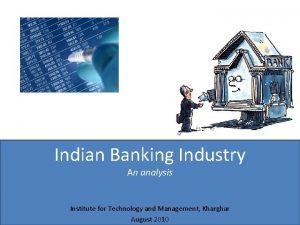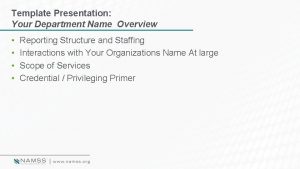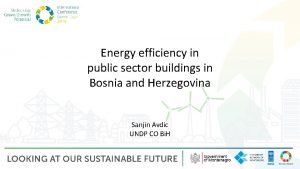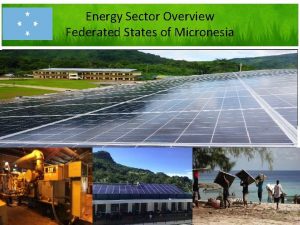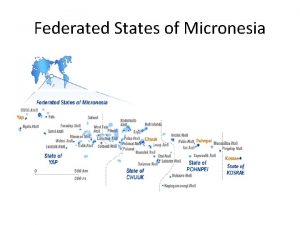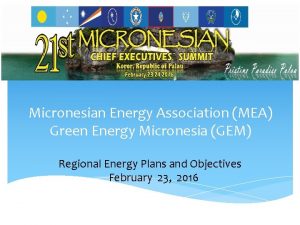Energy Sector Overview Federated States of Micronesia Department









- Slides: 9

Energy Sector Overview Federated States of Micronesia Department of Resources & Development Division of Energy FSM National Government

Federated States of of Micronesia Federated States • • 1. 3 mil sq. mile geographical area 271 sq. mile land mass 607 islands (74 inhabited islands) 102, 843 total population (2010 census) + – approximately 49, 700 residing abroad

National Energy Policy • Adopted October, 2012 • To improve the life and livelihood of all FSM citizens with affordable, reliable and environmentally sound energy. • To become less dependent on imported sources of energy by: - (1) increased share of renewable energy sources - (2) cross-sectorial energy conservation; and - (3) efficiency standards in place • By 2020 - 30% of total energy production in RE - 50% improvement in Energy Efficiency - 90% electricity access

Energy Sector Overview • Energy: integral for social and economic development • Policy addresses almost entirely on electricity (transport and others not developed yet) • FSM’s dependency on imported fuels to meet overall energy requirements: Ø Fuel imports 15% of GDP Ø Imported petroleum supports 55% of households

Energy Use Distribution 10% 12% 39% 1 2 3 4 17% 5 22% 1. Utilities 2. System Losses 4. Commercial & Industrial 3. Government 5. Residential

FSM Energy Profile State Kosrae Base (Diesel) KW Capacity Peak (Diesel) RE (done) KW Capacity RE (On going) KW Capacity 6 Total RE KW Capacity 600 1, 200 353 359 (05%) Pohnpei 3, 300 5, 800 1, 763 -0 - 1, 763 (05%) Chuuk 1, 500 2, 500 355 435 790 (05%) Yap 1, 500 2, 800 674 1, 125 1, 799 (17%) Total 6, 900 12, 300 3, 145 1, 566 4, 711 (08%) Renewable Target 30% Need 4 MW (net) or about 20 MW (Solar PV) installed

Constraints & Challenges • Separate state-owned power utility for each of the 4 states • Coordination of Energy Development (1 National Policy w/5 Action Plans) • Limited domestic capacity • Access Expansion (social responsibility vs. sustainability – cost) - Strong political will to push “access” but reluctance to support tariff to address sustainability of system. • Utilities unable to generate revenue to support further energy source development (limited resources to finance RE targets) • Land infrastructure issues/limitations • Logistics – expensive

Expectation from Workshop • Learn best practices from other (countries) in addressing similar or common challenges • Learn strategies utilized by others in advancing their targets (RE, EE, Access, etc. ) • Gain better understanding of assistance offered by Government of Japan • In sharing our situation, discuss how and where IRENA could offer technical support • Employ knowledge gained to help improve our share of the global outreach.

Thank you
